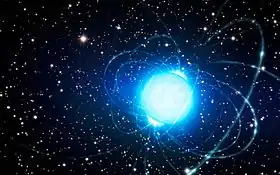CXOU J164710.2−455216
CXOU J164710.2−455216 is an anomalous X-ray pulsar in the massive galactic open cluster Westerlund 1. It is the brightest X-ray source in the cluster, and was discovered in 2005 in observations made by the Chandra X-ray Observatory.[1][2] The Westerlund 1 cluster is believed to have formed in a single burst of star formation,[3] implying that the progenitor star must have had a mass in excess of 40 solar masses. The fact that a neutron star was formed instead of a black hole implies that more than 95% of the star's original mass must have been lost before or during the supernova that produced the magnetar.[4][5]
 Artist's impression of CXOU J164710.2-455216 | |
| Observation data Epoch J2000.0 Equinox J2000.0 (ICRS) | |
|---|---|
| Constellation | Ara |
| Right ascension | 16h 47m 10.20s |
| Declination | −45° 52′ 16.8″ |
| Characteristics | |
| Evolutionary stage | Neutron star |
| Apparent magnitude () | >18.5[1] |
| Astrometry | |
| Distance | approx. 16,000 ly (approx. 5,000 pc) |
| Details | |
| Rotation | 10.6105(1)s |
| Other designations | |
CXO J164710.20−455217, CXOU J164710.2−455217 | |
| Database references | |
| SIMBAD | data |
On 21 September 2006 the Swift satellite detected a 20ms soft gamma-ray burst in Westerlund 1. Fortuitously, XMM-Newton observations had been made four days earlier, and repeat observations 1.5 days after the burst revealed the magnetar to be the source of the burst, with the X-ray luminosity increasing by a factor of 100 during the outburst.[6]
References
- A Neutron Star with a Massive Progenitor in Westerlund 1, Muno et al. (2006)
- Westerlund 1: Neutron Star Discovered Where a Black Hole Was Expected
- On the massive stellar population of the super star cluster Westerlund 1, Clark et al. (2005)
- Magnetar Formation Mystery Solved, eso1415 - Science Release (14 May 2014)
- Wood, Chris. "Very Large Telescope solves magnetar mystery" GizMag, 14 May 2014. Accessed: 18 May 2014.
- Exciting the magnetosphere of the magnetar CXOU J164710.2−455216 in Westerlund 1, Muno et al. (2007)
- Gavriil, F. P.; Woods, P. M.; Kaspi, V. M. (2006). "Chandra Target of Opportunity Observations of CXO J164710.2−455216". The Astronomer's Telegram. 901: 1. Bibcode:2006ATel..901....1G.
- cxo-j164710.2-455216